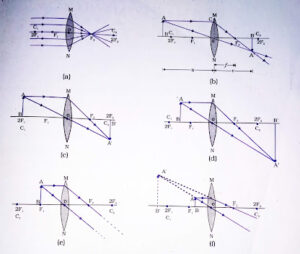Convex lens
The two spherical surfaces protruding outward in a lens are called convex lenses. Convex lens thicker in the middle than at the edges. A convex lens converges light rays, hence it is also called a converging lens.
Concave lens
A lens is surrounded by two spherical surfaces curved inwards. Concave lens is thicker at the edges than in the middle.
Such lenses diverge light rays, hence they are also called diverging lenses.
Formation of images from lenses using ray diagram
1. From the object, any ray of light coming parallel to the principal axis, after refraction from the convex lens, will pass through the principal focus on the other side of the lens and in the case of a concave lens, the ray of light appears to diverge from the principal focus on the other side of the lens.
2. The ray of light passing through the principal focus appears to emerge parallel to the principal axis of the lens after refraction from a convex lens and the ray of light that appears to meet at the principal focus of a concave lens appears to emerge parallel to the principal axis after refraction.
3.The ray of light passing through the optical centers of both the lenses passes through its straight path without any deviation after refraction.
Capacity of lens
The ability of a lens to bend rays of light is called the power of a lens.
The power of the lens is expressed as P, its unit is diopter.
1D = 1/m diopter
If the focal length of the lens is f, then the power of the lens is
tan δ = h/f
If,
h=1
tan δ = 1/f
δ = 1/f (small value of δ)
Therefore,
P=1/f
Lens formula and magnification
Just as we found the formula for spherical mirrors, similarly the lens formula has been established for spherical lenses also.
If object distance (u), image distance (v) and focal length (f) are
1/v – 1/u = 1/f
Magnification of a lens is the ratio of height of image to the height of the object. It is denoted by m.
If the height of the object is (h) and the height of the image formed by the lens is (h’), then
m = height of image/height of object
m = h’/h
The magnification produced by a lens is also related to the distance of the object (u) and the distance of the image (v).
Magnification(m) = h’/h
(m) = v/u












